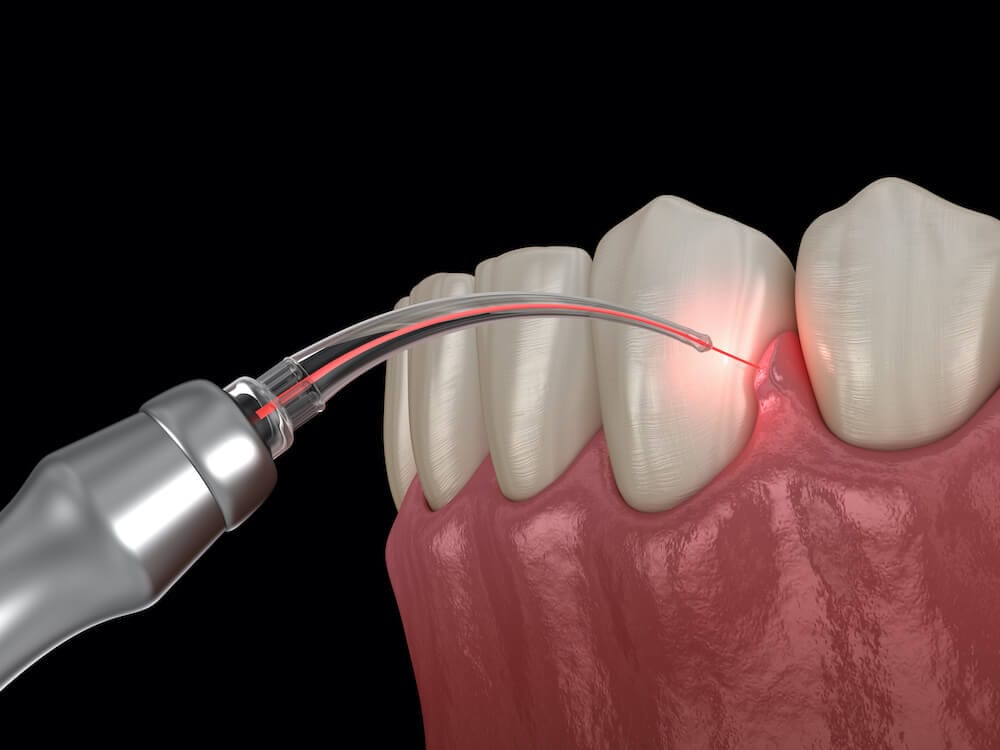Numerous innovations for lasers have arrived through the years, and this unique technology is no longer used solely in space-age type applications. Instead, lasers now have numerous uses in health care as well as in the dental sector. Dr. Pham can improve your oral health and treat a wide range of teeth and gum issues with safe and effective dental lasers.

What Is Laser Dentistry?
As its name implies, laser dentistry uses precise laser light to address a variety of hard and soft tissues in the mouth. While lasers have been used extensively since the 1960s in a variety of applications, the first dental laser was used commercially in 1990s. Since then, numerous other types of lasers have come onto the market, improving the safety and comfort for patients looking for faster appointments and more precise treatments. The word laser is actually an acronym that stands for Light Amplification by Stimulated Emission of Radiation. The narrow beam of light created by a dental laser can burrow deep into tissues to effect change far beneath the surface.
How Are Lasers Used in Dentistry?
Surprisingly, lasers have a variety of uses throughout the field of dentistry. Although they are most frequently used to treat soft tissues, they can be used to treat certain hard tissue concerns as well, including cavities and decay. In fact, some lasers can even detect early forms of tooth decay, helping dentists preemptively treat certain concerns before they become more widespread. Lasers can also seal off tiny openings in tooth enamel that create hypersensitivity to heat, cold and sweets. If you have discolored teeth, special lasers can whiten your teeth through a unique bleaching process in combination with a peroxide solution that is activated by the laser. Finally, hard-tissue lasers can precisely target spots of decay, killing bacteria found in cavities and eliminating the need for the hated dental drill while also performing thorough laser teeth cleaning.
Dental lasers have even more uses when it comes to soft tissue problems. For example, some lasers can reshape gums that are covering up too much of the tooth or to reshape the gums before placing tooth restorations. Laser dental surgery can even be used to treat periodontal disease as lasers can stimulate the tissues to begin growing once again.
There are several other unique uses for lasers in dentistry, including the following:
- Tissue biopsies
- Lesion and canker sore removal
- Throat tissue reshaping to reduce snoring and sleep apnea
- Cold sore treatments
- TMJ treatments
What Types of Lasers Are Used in Dentistry?
Several types of lasers are currently used in dentistry depending on the type of tissues to be treated. These are usually separated into hard-tissue and soft-tissue lasers.
Hard-tissue lasers include Erbium YAG lasers, which can cut through teeth and bones precisely. These lasers may be used to prepare the teeth for bonding or veneers or to get a tooth ready for a filling by removing decay.
Soft-tissue lasers, such as diode lasers and Nd:YAG lasers, are excellent for killing bacteria on the teeth and for reshaping the gums. They reduce damage to surrounding tissues and decrease blood loss by sealing off blood vessels as they work. Plus, they can seal nerve endings so that you do not feel much discomfort.
What Are the Benefits of Laser Dentistry?
Because dental lasers are so precise, they are incredibly beneficial for a wide range of oral health problems. They are also far superior to numerous traditional methods for treating tooth and gum concerns. If Dr. Pham recommends a laser dentistry treatment for you, you can expect to enjoy the following benefits.
- Decreased discomfort as the laser works precisely and seals off nerve endings
- Decreased anxiety for patients who are particularly concerned about dental drills
- Decreased bleeding and swelling during gum treatments
- Decreased damage to nearby soft tissues
- Decreased need for sutures after soft tissue treatments
- Decreased need for local anesthesia
- Decreased loss of tooth enamel with precise treatments
- Improved wound healing
- Improved tissue regeneration



